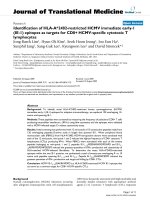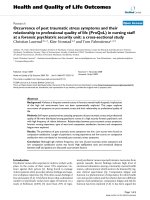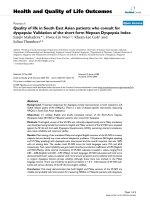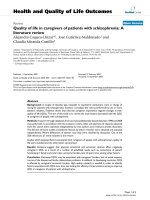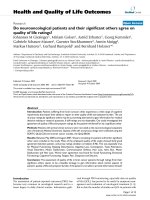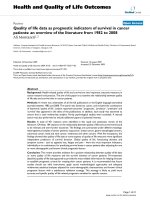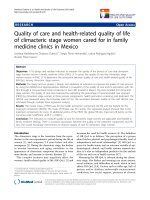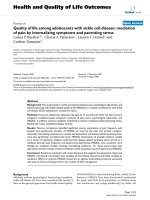báo cáo hóa học:" Quality of life and hormone use: new validation results of MRS scale" doc
Bạn đang xem bản rút gọn của tài liệu. Xem và tải ngay bản đầy đủ của tài liệu tại đây (217.37 KB, 5 trang )
BioMed Central
Page 1 of 5
(page number not for citation purposes)
Health and Quality of Life Outcomes
Open Access
Research
Quality of life and hormone use: new validation results of MRS scale
Jürgen Dinger
1
, Thomas Zimmermann
2
, Lothar AJ Heinemann*
1
and
Diana Stoehr
3
Address:
1
Center for Epidemiology & Health Research Berlin, Invalidenstr. 115, 10115 Berlin, Germany,
2
Jenapharm, Medical Affairs Gynecology,
Otto-Schott-Str. 15, 07745 Jena, Germany and
3
University of Wuerzburg, Chair of Statistics, Am Hubland, 97074 Würzburg, Germany
Email: Jürgen Dinger - ; Thomas Zimmermann - ;
Lothar AJ Heinemann* - ; Diana Stoehr -
* Corresponding author
Abstract
Background: The Menopause Rating Scale is a health-related Quality of Life scale developed in the early
1990s and step-by-step validated since then. Recently the MRS scale was validated as outcomes measure
for hormone therapy. The suspicion however was expressed that the data were too optimistic due to
methodological problems of the study. A new study became available to check how founded this suspicion
was.
Method: An open post-marketing study of 3282 women with pre- and post- treatment data of the self-
administered version of the MRS scale was analyzed to evaluate the capacity of the scale to detect
hormone treatment related effects with the MRS scale. The main results were then compared with the
old study where the interview-based version of the MRS scale was used.
Results: The hormone-therapy related improvement of complaints relative to the baseline score was
about or less than 30% in total or domain scores, whereas it exceeded 30% improvement in the old study.
Similarly, the relative improvement after therapy, stratified by the degree of severity at baseline, was lower
in the new than in the old study, but had the same slope. Although we cannot exclude different treatment
effects with the study method used, this supports our hypothesis that the individual MRS interviews
performed by the physician biased the results towards over-estimation of the treatment effects. This
hypothesis is underlined by the degree of concordance of physician's assessment and patient's perception
of treatment success (MRS results): Sensitivity (correct prediction of the positive assessment by the
treating physician) of the MRS and specificity (correct prediction of a negative assessment by the physician)
were lower than the results obtained with the interview-based MRS scale in the previous publication.
Conclusion: The study confirmed evidence for the capacity of the MRS scale to measure treatment
effects on quality of life across the full range of severity of complaints before treatment. The difference of
the relative improvement after therapy between the old and current study as well as the observed different
sensitivity/specificity is – as a matter of probability – more likely to be caused by a bias introduced by the
different application of the MRS scale than by real differences in the efficacy of the therapy. A randomized
clinical trial would be needed to test the impact of the latter. The message for future studies is: The MRS
scale should be only used as self-administered tool where the suggestive effect of questions raised by
health professionals ("therapeutic optimism") can be largely excluded.
Published: 31 May 2006
Health and Quality of Life Outcomes 2006, 4:32 doi:10.1186/1477-7525-4-32
Received: 23 January 2006
Accepted: 31 May 2006
This article is available from: />© 2006 Dinger et al; licensee BioMed Central Ltd.
This is an Open Access article distributed under the terms of the Creative Commons Attribution License ( />),
which permits unrestricted use, distribution, and reproduction in any medium, provided the original work is properly cited.
Health and Quality of Life Outcomes 2006, 4:32 />Page 2 of 5
(page number not for citation purposes)
Background
The Menopause Rating Scale (MRS) was developed in the
early 1990s and later revised from a interview to self-
administered symptom-profile instrument [1,2] to
describe health-related quality of life (HRQoL).
The MRS scale became internationally well accepted as far
as the usage in numerous countries is concerned. The first
translation was from German into English [3]. Other
translations followed [4] respecting international meth-
odological recommendations. Currently, 23 language ver-
sions are available – either published or can be
downloaded in PDF-format from the official website
[4,5].
The validation of the revised MRS began some years ago
[2,6-8] and led to quite acceptable psychometric charac-
teristics of the scale [9]. Recently, we published in this
journal data about the capacity of the scale to assess
changes pre-/post hormone treatment. In absence of other
data we analysed the MRS scale used in the old interview
version and found astonishingly positive results for this
type of validity. We discussed that this high consistency
could be an overestimate due to the interference of the
treatment-related changes perceived by patients and the
physician as "interviewer" [10].
In the meantime, we got data for a new analysis based on
the self-administered MRS, i.e. with no direct influence by
the treating physician. It is the aim of this paper to present
the new data and to discuss whether or not the conclu-
sions about the sensitivity of the MRS as outcome measure
were correct or need correction.
Methods
The new study alike the previous one is an open post-mar-
keting study. The study was conducted with a product for
hormone therapy (Lafamme
®
= 2 mg estradiol valerate + 2
mg dienogest) using the MRS scale as outcome measure
under routine conditions of office-based gynecologists.
In brief, gynecologists from all parts of Germany partici-
pated in a post-marketing study on a voluntary basis.
4262 women who required hormone treatment started
participation in this follow-up study after having pre-
scribed the hormone therapy, but 117 women stopped
soon. Beside other variables, the MRS scores were docu-
mented before therapy and 6 months after starting the
hormone treatment.
The statistical analyses were performed with the commer-
cial statistical package SAS 10.0.
Results and comments
Altogether, 4145 women had baseline (pre-treatment)
data, but only 3332 completed the MRS also after 6
months. Finally, 3282 women provided data with all nec-
essary variables for analysis. Characteristics of these par-
ticipants: The mean age (SD) was 53.9 (5.6) years (20%
under 50 years, 66% between 50–60 years, and 14% over
60 years). The mean BMI was 26.1 (4.2).
The improvement of the health-related quality of life
(HRQoL) – measured with the self-administered MRS
scale – is described in Table 1. The means (SD) of the scor-
ing points of the total scale (and the three subscales)
improved significantly (p < 0.001 for all comparisons:
operating analysis – Wilcoxon signed rank test) both in
absolute and relative terms (= compared with baseline).
In addition, this table compares these data with the rele-
vant data from the old study [10] where the interview ver-
sion of the MRS was used. In average, the scores improved
by almost one third after six months of hormone treat-
ment. However, the treatment effects were less pro-
nounced than in the old study. The major difference
between both studies is that the old one applied the MRS
scale in an interview by the physician, in the new one
however the MRS scale was self-administered and com-
pleted by the patient. The difference is notable for the psy-
chological domain, but also for the total score.
Table 1: Improvement of MRS scores after therapy by absolute difference in scoring points.
§
Mean values (SD) for the total scale and
for each subscale. Comparison between this study and the previous one (see text)
Absolute change
§
Relative change
#
(%)
New study Old study** New study Old study**
Total scale 8.2 (6.5) 9.3 (7.4) 30.7 (18.6) 36.1 (20.6)
Psychological subscale 2.9 (3.0) 3.8 (3.7) 27.8 (23.4) 34.5 (27.1)
Somatic subscale 3.6 (2.8) 3.6 (3.0) 33.5 (22.1) 37.3 (23.1)
Urogenital subscale 1.7 (2.0) 1.8 (2.3) 22.4 (24.3) 24.5 (25.3)
§
Summary score "before therapy" minus "after therapy"
# Percent (%) change compared with the score before treatment: pre-treatment score minus post-treatment score divided by pre-treatment score
multiplied by 100 (%)
** see Ref [9]
Health and Quality of Life Outcomes 2006, 4:32 />Page 3 of 5
(page number not for citation purposes)
A possible bias between the initial study and this one
could have been the difference in the drug formulation,
but as a matter of probability this is likely to be explained
by the form of application of the scale: The interview
interferes obviously with the answer pattern of the
patients, i.e. the patients might often intend to please the
physician with a favorable assessment of his therapy. The
pronounced difference in the psychological domain may
support such an interpretation. Other notable differences
between the two studies are the age of the study popula-
tion and the type of HRT used. The participants of the first
study were about 5 years younger on average, and another
progestin with a different application regimen was used
for treatment. We think, however, that the difference
between the two MRS versions had a much bigger impact
than the age or type of HRT. We assume that the effect of
hormones did not play a role. This hypothesis however
can only be tested with a randomized clinical trial that
compares the efficacy of different products used in our
two studies.
With the MRS scale various degrees of improvement ca be
measured. This makes the scale suitable for follow-up of
patients with few and mild complaints before therapy (=
baseline) as well as those with severe symptomatology.
This is presented in Table 2: The more severe the com-
plaints were before treatment the better the effect regard-
ing relative improvement of symptoms measured by the
MRS, which speaks in favour of the clinical utility of the
MRS as outcome measure. In comparison to the mean
changes in all patients the differences between the self-
administered and the interview version of the MRS were
even more pronounced in all patients who had "mild",
"moderate", or "severe" complaints at baseline. The differ-
ences between the test versions are only negligible in
patients who had "no/little" complaints.
We also compared the MRS total score before and after
hormone treatment with the norm values of MRS of the
average female population aged 45–60 years [2,3]. This
crude and simple comparison showed that the severely
deteriorated distribution of complaints in the patient
group before therapy – compared with the normal popu-
lation – improved after therapy remarkably and reached
almost the distribution of the normal population (data
not shown).
In the previously published "old" study [10] we found a
more exaggerated result. We discussed selection problems
of the post-marketing study and also problems of the
interview technique as reasons for an unexpected high
proportion of patients without complaints after hormone
therapy. This could support our hypothesis that a per-
sonal interview by the physician may bias the outcome
toward over-estimation of the treatment effect.
Overall, it is worth noting that the MRS scale can obvi-
ously detect treatment effects even in persons with little or
mild symptoms before therapy – although to a lesser
degree. We cannot comment as to what extend the MRS
scale is able to differentiate between true or placebo treat-
ment effects. The study cannot contribute to such a discus-
sion due to its study design. However, we consider a
relative improvement of 20 to 30%, which represents for
example the improvement from severe to moderate com-
plaints, as clinically relevant difference. Therefore, we rec-
ommend using an improvement of more than 20% as
threshold to establish an "effect" of a new treatment.
A last issue is the validity of outcome evaluation by means
of the MRS scale when the subjective assessment by the
physician is taken as "gold standard". The treating gynae-
cologist assessed the "success" of the treatment for each
person. We compared the agreement between this judge-
ment and the assessment derived from a defined cut-off
point of the self-administered MRS total score.
In the previous study [10] we observed an unexpected
good sensitivity/specificity: sensitivity (correct prediction
of a positive assessment by the physician) 70.8% and spe-
Table 2: Relative change of MRS scores as percent of the baseline score: Mean values (SD) of the relative change (= % improvement of
the complaints) in four categories of severity at baseline. The range of baseline scores is given in brackets for each category of severity.
New study is the current analysis, the old study was recently published: * see REF [9]
Severity of complaints at baseline
No/little (0–4) Mild (5–8) Moderate (9–15) Severe (16+)
Total score New study 8.0 (12.9) 22.9 (12.9) 32.7 (13.9) 43.3 (15.5)
Old study* 10.8 (10.6) 32.2 (9.8) 43.9 (11.8) 55.1 (13.8)
Psychological score New study 5.8 (16.5) 18.2 (19.7) 28.1 (20.5) 42.8 (19.8)
Old study* 6.0 (14.7) 27.6 (21.5) 43.7 (20.6) 57.1 (17.9)
Somatic score New study 10.4 (20.4) 26.1 (20.8) 36.8 (17.8) 44.9 (17.3)
Old study* 13.8 (17.3) 34.4 (18.5) 44.1 (16.9) 54.8 (15.9)
Urogenital score New study 2.0 (18.1) 13.4 (19.0) 22.5 (22.3) 36.5 (22.0)
Old study* 5.7 (13.9) 17.0 (20.6) 27.5 (23.6) 44.4 (22.6)
Health and Quality of Life Outcomes 2006, 4:32 />Page 4 of 5
(page number not for citation purposes)
cificity (correct prediction of a negative assessment by the
physician) 73.5%. We expressed concern that the degree
of concordance might be overestimated due to the above
mentioned study limitation (interview by physician). Our
current study based directly on patients' information
(physician neither present when the scale was completed
nor when the scale was evaluated) came to somewhat but
not much lower conformity with physicians' assessment.
Table 3 shows that with a cut-off point between 20 and
22% of therapy-related improvement the sensitivity is
around 70%, but the specificity is only between 50–60%
and thereby markedly lower than in the previous study. In
the previous study, the clinical judgement about "treat-
ment success" was done by the physician who was respon-
sible for the chosen treatment. We assume that in many
cases the true treatment effect is better reflected by the self-
administered MRS then by this form of clinical judge-
ment. Together with the above discussed relative improve-
ment of the complaints after therapy, the sensitivity and
specificity results obtained in our current study point into
the direction of a bias mainly introduced by application of
the MRS scale as interview by the treating physician.
We hope to get access to data of double-blinded, rand-
omized clinical trials to confirm the results of this valida-
tion study, i.e. to know the impact of treatment efficacy.
But even on the basis of the information available from
our two studies, the available information is re-assuring
concerning methodological quality of the MRS scale as
clinical utility.
Conclusion
The study confirmed evidence for the capacity of the MRS
scale to measure treatment effects on quality of life across
the full range of severity of complaints before treatment.
The difference of the relative improvement after therapy
between the old and current study as well as the observed
different sensitivity/specificity is – as a matter of probabil-
ity – more likely to be caused by a bias introduced by the
different application of the MRS scale than by real differ-
ences in the efficacy of the therapy. A randomized clinical
trial would be needed to test the impact of the latter. The
message for future studies is: The MRS scale should be
only used as self-administered tool where the suggestive
effect of questions raised by health professionals ("thera-
peutic optimism") can be largely excluded.
Competing interests
TZ is employee of a company that produces hormone
products.
The authors, however, see no conflict of interest as far as
the validation of the MRS scale is concerned.
Authors' contributions
JD: contributed to the design of the study, the validation
analysis and the writing of the manuscript; TZ: responsi-
ble for design and execution of the post-marketing study;
LAJH: one of the developers of the MRS scale, responsible
for the design of this validation analysis, and involved in
writing the manuscript; DS: responsible for setting up and
managing the database for different analyses, and for run-
ning all analyses.
Table 3: Values for Sensitivity and Specificity of predicting
physicians assessment of "successful therapy". Sensitivity and
specificity is listed for a series of cut-off points (given in percent
of baseline total score) for relative score improvement on the
total MRS-scale.
Cut-off Point Relative
score improvement (%)
Sensitivity (%) Specificity (%)
≥ 5 92.1 22.7
≥ 10 87.4 33.6
≥ 15 81.6 42.8
≥ 20 73.4 53.3
≥ 22 70.1 57.2
≥ 25 63.9 62.9
≥ 30 54.6 75.6
≥ 35 44.1 79.9
≥ 40 33.1 88.2
Publish with BioMed Central and every
scientist can read your work free of charge
"BioMed Central will be the most significant development for
disseminating the results of biomedical research in our lifetime."
Sir Paul Nurse, Cancer Research UK
Your research papers will be:
available free of charge to the entire biomedical community
peer reviewed and published immediately upon acceptance
cited in PubMed and archived on PubMed Central
yours — you keep the copyright
Submit your manuscript here:
/>BioMedcentral
Health and Quality of Life Outcomes 2006, 4:32 />Page 5 of 5
(page number not for citation purposes)
Acknowledgements
The authors thank Horst Dietrich, Jenapharm for creating the initial data-
base of the post-marketing study and for providing the limited dataset for
this validation study.
References
1. Hauser GA, Huber IC, Keller PJ, Lauritzen C, Schneider HPG: Eval-
uation der klinischen Beschwerden (Menopause Rating
Scale). Zentralbl Gynakol 1994, 116:16-23.
2. Potthoff P, Heinemann LAJ, Schneider HPG, Rosemeier HP, Hauser
GA: Menopause-Rating Skala (MRS): Methodische Standard-
isierung in der deutschen Bevölkerung. Zentralbl Gynakol 2000,
122:280-286.
3. Schneider HPG, Heinemann LAJ, Thiele K: The Menopause Rating
Scale (MRS): Cultural and linguistic translation into English.
Life and Medical Science Online 2002, 3:. DOI:10.1072/LO0305326
4. Heinemann LAJ, Potthoff P, Schneider HPG: International versions
of the Menopause Rating Scale (MRS). Health Qual Life Out-
comes 2003, 1:28.
5. [o
].
6. Heinemann K, Assmann A, Möhner S, Schneider HPG, Heinemann
LAJ: Reliabilität der Menopause-Rating-Skala (MRS). Unter-
suchung für die Deutsche Bevölkerung. Zentralbl Gynakol 2002,
124:161-163.
7. Schneider HPG, Heinemann LAJ, Rosemeier HP, Potthoff P, Behre
HM: The Menopause Rating Scale (MRS): Reliability of scores
of menopausal complaints. Climacteric 2000, 3:59-64.
8. Schneider HPG, Heinemann LAJ, Rosemeier HP, Potthoff P, Behre
HM: The Menopause Rating Scale (MRS): Comparison with
Kupperman Index and Quality of Life Scale SF-36. Climacteric
2000, 3:50-58.
9. Heinemann K, Ruebig A, Potthoff P, Schneider HPG, Strelow F, Hein-
emann LAJ, Do Minh T: The Menopause Rating Scale (MRS)
scale: A methodological review. Health Qual Life Outcomes 2004,
2:45.
10. Heinemann LAJ, DoMinh T, Strelow F, Gerbsch S, Schnitker J, Schnei-
der HPG: The Menopause Rating Scale (MRS) as outcome
measure for hormone treatment? Health and Quality of Life Out-
come 2004, 2:67 [ />]. Doi:10.1186/
1477-7525-2-67
≥ 45 24.2 91.3
≥ 50 14.7 94.3
Table 3: Values for Sensitivity and Specificity of predicting
physicians assessment of "successful therapy". Sensitivity and
specificity is listed for a series of cut-off points (given in percent
of baseline total score) for relative score improvement on the
total MRS-scale. (Continued)
